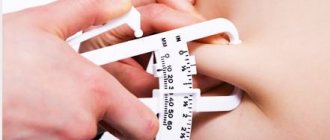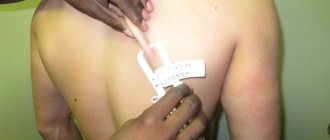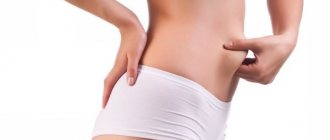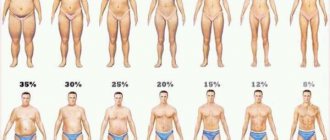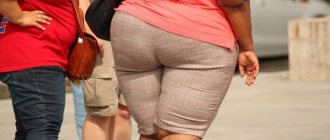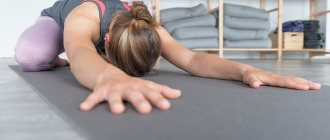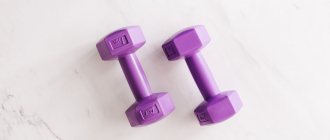How to calculate body fat percentage? Why do you need to know your body fat percentage? We'll figure it out together with a trainer and an endocrinologist.
The number on the scale is far from the most important indicator of physical fitness. The ratio of fat to muscle mass is what really matters. We will tell you below how to correctly assess your body composition.
Alexander Kozhevnikov
trainer, rehabilitation specialist, nutritionist
The higher the percentage and amount of fat in the body, the higher the risk of developing complications and diseases of the cardiovascular system, musculoskeletal system and endocrine system.
How to measure?
Stand up straight, straighten your back. Grab the fold of skin and fat just below the navel horizontally - thumb on top, index finger on bottom. Place the ruler horizontally, resting its end on the stomach, and measure the thickness of the fold in millimeters. Then find the resulting value in the table below based on your age. The content of adipose tissue in the body of women (in percent)
| Subcutaneous fat fold, mm | 18-29 years old | 30-39 years old | 40-49 years old | 50 or more years |
| 15 | 10,5 | — | — | — |
| 20 | 14,1 | 17 | 19,8 | 21,4 |
| 25 | 16,8 | 19,4 | 22,2 | 24 |
| 30 | 19,5 | 21,8 | 24,5 | 26,6 |
| 35 | 21,5 | 23,7 | 26,4 | 28,5 |
| 40 | 23,4 | 25,5 | 26,2 | 30,3 |
| 45 | 25 | 26,9 | 29,6 | 31,9 |
| 50 | 26,5 | 28,2 | 31 | 33,4 |
| 55 | 27,8 | 29,4 | 32,1 | 34,6 |
| 60 | 29,1 | 30,6 | 33,2 | 35,7 |
| 65 | 30,2 | 31,6 | 34,1 | 36,7 |
| 70 | 31,2 | 32,5 | 35 | 37,7 |
| 75 | 32,2 | 33,4 | 35,9 | 38,7 |
| 80 | 33,1 | 34,3 | 36,7 | 39,6 |
| 85 | 34 | 35,1 | 37,5 | 40,4 |
| 90 | 34,6 | 35,8 | 38,1 | 41,2 |
| 95 | 35,6 | 36,5 | 39 | 41,9 |
| 100 | 36,4 | 37,2 | 39,7 | 42,6 |
| 105 | 37,1 | 37,9 | 40,4 | 43,3 |
| 110 | 37,8 | 38,6 | 41 | 43,9 |
| 115 | 38,4 | 39,1 | 41,5 | 44,5 |
| 120 | 39 | 39,6 | 42 | 45,1 |
| 125 | 39,6 | 40,1 | 42,5 | 45,7 |
| 130 | 40,2 | 40,6 | 43 | 46,2 |
| 135 | 40,8 | 41,1 | 43,5 | 46,7 |
| 140 | 41,3 | 41,6 | 44 | 47,2 |
| 145 | 41,8 | 42,1 | 44,5 | 47,7 |
| 150 | 42,3 | 42,6 | 45 | 48,2 |
| 155 | 42,8 | 43,1 | 45,4 | 48,7 |
| 160 | 43,3 | 43,6 | 45,8 | 49,2 |
| 165 | 43,7 | 44 | 46,2 | 49,6 |
| 170 | 44,1 | 44,4 | 46,6 | 50 |
| 175 | 44,4 | 44,8 | 47 | 50,4 |
| 180 | 44,7 | 45,2 | 47,4 | 50,8 |
| 185 | 45 | 45,6 | 47,8 | 51,2 |
| 190 | 45,3 | 45,9 | 48,2 | 51,6 |
| 195 | 45,5 | 46,2 | 48,5 | 52 |
| 200 | 45,5 | 46,5 | 48,8 | 52,4 |
| 205 | 45,8 | 46,8 | 49,1 | 52,7 |
| 210 | 46 | 47,1 | 49,4 | 53 |
Content of adipose tissue in the body of men (in percent)
| Subcutaneous fat fold, mm | 18-29 years old | 30-39 years old | 40-49 years old | 50 or more years |
| 15 | 4,8 | — | — | — |
| 20 | 8,1 | 12,2 | 12,2 | 12,6 |
| 25 | 10,5 | 14,2 | 15 | 15,6 |
| 30 | 12,9 | 16,2 | 17,7 | 18,6 |
| 35 | 14,7 | 17,7 | 19,6 | 20,8 |
| 40 | 16,4 | 19,2 | 21,4 | 22,9 |
| 45 | 17,7 | 20,4 | 23 | 24,7 |
| 50 | 19 | 21,5 | 24,6 | 26,5 |
| 55 | 20,1 | 22,5 | 25,9 | 27,9 |
| 60 | 21,2 | 23,5 | 27,1 | 29,2 |
| 65 | 22,2 | 24,3 | 28,2 | 30,4 |
| 70 | 23,1 | 25,1 | 29,3 | 31,6 |
| 75 | 24 | 25,9 | 30,3 | 32,7 |
| 80 | 24,8 | 26,6 | 31,2 | 33,8 |
| 85 | 25,5 | 27,2 | 32,1 | 34,8 |
| 90 | 26,2 | 27,8 | 33 | 35,8 |
| 95 | 26,9 | 28,4 | 33,7 | 36,6 |
| 100 | 27,6 | 29 | 34,4 | 37,4 |
| 105 | 28,2 | 29,6 | 35,1 | 38,2 |
| 110 | 28,8 | 30,1 | 35,8 | 39 |
| 115 | 29,4 | 30,6 | 36,4 | 39,7 |
| 120 | 30 | 31,1 | 37 | 40,4 |
| 125 | 30,5 | 31,5 | 37,6 | 41,1 |
| 130 | 31 | 31,9 | 38,2 | 41,8 |
| 135 | 31,5 | 32,3 | 38,7 | 42,4 |
| 140 | 32 | 32,7 | 39,2 | 43 |
| 145 | 32,5 | 33,1 | 39,7 | 43,6 |
| 150 | 32,9 | 33,5 | 40,2 | 44,1 |
| 155 | 33,3 | 33,9 | 40,7 | 44,6 |
| 160 | 33,7 | 34,3 | 41,2 | 45,1 |
| 165 | 33,7 | 34,6 | 41,6 | 45,6 |
| 170 | 34,5 | 34,8 | 42 | 46,1 |
| 175 | 34,9 | 35 | 42,4 | 46,5 |
| 180 | 35 | 35,2 | 42,8 | 46,9 |
| 185 | 35,6 | 35,4 | 43 | 47,3 |
| 190 | 35,9 | 35,6 | 43,3 | 47,7 |
At what points should measurements be taken?
Triceps (back of shoulder):
The point is located exactly halfway between the shoulder and elbow joints. The fold is taken in a vertical direction directly at the center of the back of the shoulder.
Biceps ( front of shoulder ):
It is measured in the same way as the triceps, only in this case the crease is taken at the front of the shoulder.
Spatula:
Just below the shoulder blade. The fold is taken at an angle of 45 degrees, as shown in the figure.
Waist:
Just above the ilium and pelvic bone. The fold is taken almost horizontally, as shown in the figure.
When is the method useful?
Typically, healthy weight limits are calculated using the body mass index
(BMI) formula.
But the resulting value does not always reflect the real picture. An increased BMI can be observed in people with developed muscles, while a normal BMI can be observed in an unathletic person with a fragile physique and decent fat reserves. To more accurately determine your condition, it is better to evaluate two indicators at once
- BMI and body fat percentage.
For example, if, with a decrease in BMI, the percentage of fat remains unchanged, weight loss occurs due to a decrease in muscle mass, which can be called exhaustion of the body. If BMI increases, a change in the percentage of fat will show whether the weight is increasing - muscle mass is growing, or fat reserves are being deposited. According to Korochkin, this method of calculation is suitable for those who regularly train to lose weight. In this situation, it is not the exact knowledge of weight, BMI and body fat percentage that is important, but the change in these values over time
. “Even if there is an error in the table or your measurements,” notes Korochkin, “the dynamics of changes in values will show whether you are moving in the right direction.”
Look beyond the weight scale
The scale can't tell you exactly how much fat you have in your body, but these indicators can:
- Wardrobe: clothes have become big? Are you able to wear more and more things from your youth?
- Sets and Reps in the Gym: Has Performance Improved? Can you exercise longer, lift heavier weights, or perform exercises without the same effort?
- Daily tasks: Do you find it easier to carry bags or clear snow in winter?
- Energy levels: Do you feel more fit and less tired when you wake up?
- Reflection: how do you look in the mirror - flabby or toned and sexy?
How to estimate your body fat percentage
Relative content of adipose tissue in the body of women (in percent)
| Characteristic | Age, years | ||||
| 18-29 | 30-39 | 40-49 | 50-59 | >60 | |
| Very low | |||||
| Low | 16-19 | 17-20 | 18-21 | 19-22 | 20-23 |
| Optimal | 20-28 | 21-29 | 22-30 | 23-31 | 24-32 |
| Moderate high | 29-31 | 30-32 | 31-33 | 32-33 | 33-35 |
How to lose weight through sports?
Basic rules of training, diet and useful links in the material for those who want to learn how to lose weight correctly and reliably.
Relative content of adipose tissue in the body of men (in percent)
| Characteristic | Age, years | ||||
| 18-29 | 30-39 | 40-49 | 50-59 | >60 | |
| Very low | |||||
| Low | 11-13 | 12-14 | 14-16 | 15-17 | 16-18 |
| Optimal | 14-20 | 15-21 | 17-23 | 18-24 | 19-25 |
| Moderate high | 21-23 | 22-24 | 22-26 | 25-27 | 26-28 |
Sensational news about brown fat
Two studies in an English medical journal about a special form of thermogenically active fat tissue that releases excessive amounts of energy when processed have unexpectedly attracted media attention. One headline even read: "Brown Fat: The Fat That Will Help You Lose Weight?"
"Brown or brown fat generally doesn't matter," says Fabio Comana, an exercise physiologist at the American Council on Exercise. “Thousands of years ago, it helped keep us warm during the cold months.” But these days we don't have to worry about cold weather - we have clothes, houses and heaters, so it's mostly hype.
If there is too little fat?
A reduced body fat content is not a reason for pride, but a reason for reviewing your diet.
Lack of adipose tissue in the body disrupts the functioning of the endocrine system. In this case, women may stop menstruating and experience early signs of osteoporosis, a disease in which bones lose calcium and become very fragile. In addition, if the fat layer in the lower back and hips completely disappears, the kidneys and organs of the reproductive system are deprived of protection from the cold. When hypothermia occurs, a woman runs the risk of developing inflammatory processes in the pelvic organs. Myths about losing weight
Are there products to burn fat in specific areas? Is it possible to lose weight quickly and effectively? What do the scales show before and after training? Let's talk.
What is the best way to find out how much body fat you have?
Examples of ways to measure fat:
Caliper
Cost: from 900 to 24,000 rubles
Accuracy: error rate ±3%; basically measures fat under the skin
Availability: most fitness clubs
Appliances for home use
Cost: from 1,200 to 18,000 rubles for a machine that determines body fat using the electrical resistance method
Accuracy: error rate ±3%
Availability: Can be purchased online
Hydrostatic test (underwater)
Cost: from 900 to 3000 rubles per test
Accuracy: error rate ± 1.5%
Availability: Typically conducted at research institutes and universities
If there is too much fat?
Too much body fat indicates an increased risk of developing cardiovascular diseases and metabolic diseases, such as hypertension and type 2 diabetes. Particularly dangerous for both men and women is the so-called abdominal obesity - the deposition of fat reserves in the waist area. It increases the risk of developing cardiovascular disease by five times. A real cause for alarm appears when the waist circumference in men exceeds 102, and in women - 88 centimeters.
How to Determine Muscle Loss or Gain
Measuring muscle loss or gain is one of the most important areas where body fat data can be used. Knowing your fat percentage and weight, you can easily determine your “lean body mass.” Since muscle tissue is a component of muscle mass, changes in “lean mass” are caused by changes in muscle mass.
In order to determine lean mass, it is necessary to measure body fat and body weight as accurately as possible. After dieting or training, measurements must be repeated. Any change in muscle mass reflects how much muscle you have lost or gained.
Example for men: For example, a man weighing 95 kilograms, body fat percentage 30%. We multiply 95 kg by 30%, we get 28.5 kg - the weight of fat contained in the body. Subtract 28.5 from 95 and get 66.5 - lean mass. After a month of regular training and proper nutrition, his weight dropped to 88 kilograms, and his fat percentage dropped to 25% (22 kg). Thus, now his lean mass is 66, that is, in a month he lost 500 grams of muscle and 6.5 kilograms of fat. An excellent result, indicating that he chose the right training and nutrition program.
In the form of formulas, all calculations will look like this:
Before: Fat mass = 30% and Body weight = 95 kg. 95 x 0.30 = 28.5 kg. 95 – 28.5 = 66.5 kg. lean mass
After: Fat Mass = 25% and Body Weight = 88 lbs 88 x 0.25 = 22 kg. 88 – 22 = 66 kg. lean mass
Difference: 66.5 – 66 = 0.5 kg. loss of muscle mass 28.5 – 22 = 6.5 kg. fat loss
Example for women:
Woman weighing 68 kilograms, body fat percentage 30%. Fat mass will be 20.4 kg. We subtract the resulting number from her 68 kilogram weight and get 47.6 kg of lean mass. After a month of a low-calorie diet, she lost 10 kilograms and now weighs 58 and has a body fat percentage of 27% (15.6 kg). Lean weight – 42.4 kg. Thus, the loss of muscle mass was 5.2 kg, and fat loss - 4.8 kg. It follows that she lost almost equal amounts of muscle tissue and fat, which indicates an incorrectly chosen weight loss program.
In the form of formulas, all calculations will look like this:
Before: Fat mass = 30% and Body weight = 68 kg. 68 x 0.30 = 20.4 kg. 68 – 20.4 = 47.6 kg. lean mass
After: Fat mass = 27% and Body weight = 58 kg. 58 x 0.27 = 15.6 kg. 58 – 15.6 = 42.4 kg. lean mass
Difference: 47.6 – 42.4 = 5.2 kg. loss of muscle mass 20.4 – 15.6 = 4.8 kg. fat loss
People who have lost a lot of muscle and gained a lot of fat due to inactivity can actually gain back lost muscle and burn fat at the same time. For example, a 68-year-old man weighs 70 kg. The sum of the measurements taken with the caliper indicates 28% fat. That's 19.6 kilograms of fat and 50.4 kilograms of lean mass. After 4 months of active strength training and the right month, his weight dropped to 68 kg and his body fat percentage dropped to 18%. Thus, fat mass was 12.2 kg and lean mass was 55.8 kg. That is, in 4 months he lost 7.4 kg of fat and gained 5.4 kg of muscle.
Schematically:
Before: Fat mass = 28% and Body weight = 70 kg. 70 x 0.28 = 19.6 kg. 70 – 19.6 = 50.4 kg. lean mass
After: Fat mass = 18% and Body weight = 68 kg. 68 x .18 = 12.2 kg. 68 – 12.2 = 55.8 kg. lean mass
Difference: 55.8 – 50.4 = 5.4 kg. muscle mass gain 19.6 – 12.2 = 7.4 kg. fat loss
How and what to measure?
You need to measure your height, weight, waist, neck and hip circumference. Also indicate your daily activity level. Enter the obtained measurements into the calculator, click the “Calculate” button.
| What's your gender | What's your gender |
| Your height (in centimeters): | |
| Your weight (in kilograms): | |
| Your waist (in centimeters): | |
| Your neck (in centimeters): | |
| Your hips (in centimeters): | |
| Physical activity: | Physical activity: |
Body parameters
To take measurements you will need a measuring tape and scales. Take measurements with an accuracy of 0.5 cm. Make sure that the measuring tape does not tighten the skin, but does not hang loosely.
- Height – measure your height without shoes;
- Weight – get on the scale in the morning, without clothes, first visit the toilet and not have breakfast;
- Waist - for men, measure the waist in the navel area, for women - in the narrowest part of the abdominal cavity;
- Neck – measure the circumference of the neck under the Adam’s apple;
- Hips – measure at the widest part of the hips.
Activity level
- Minimal – passive lifestyle, computer work, rare irregular exercise;
- Moderate – daily walking, work in motion, active recreation;
- Active – regular exercise, heavy physical work.
